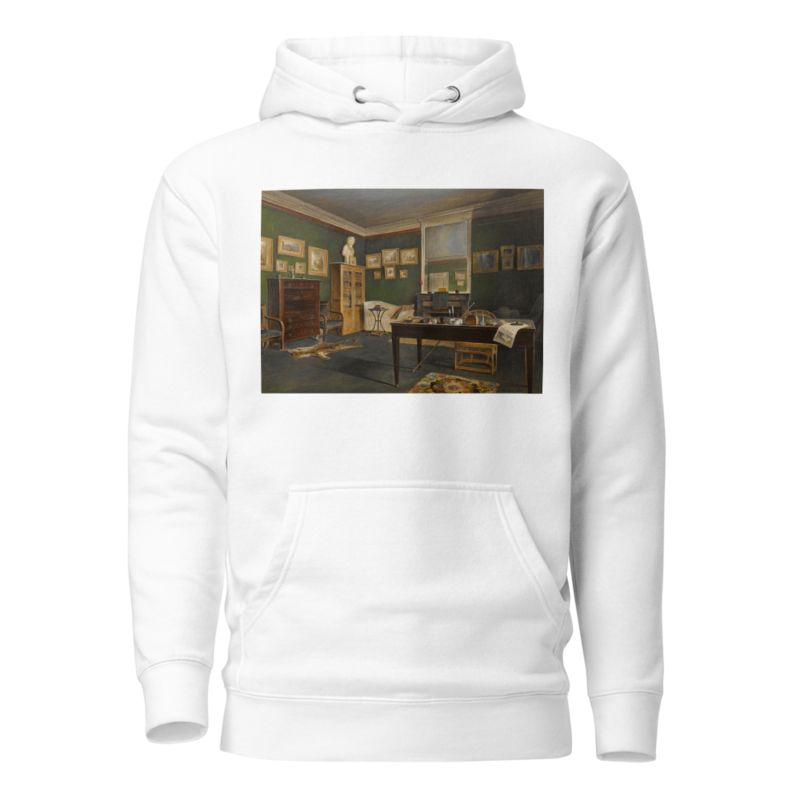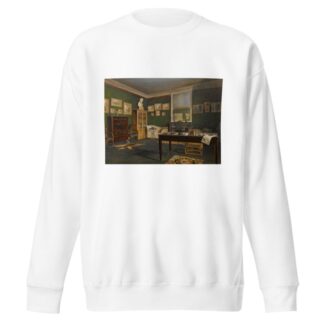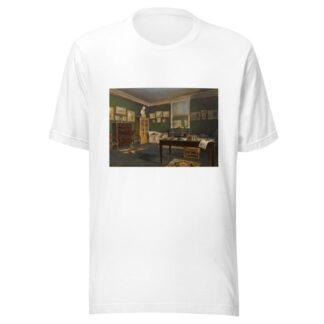Description
The interior of an artist’s studio by Jean-Jacques Champin printed on a Hoodie
About the Hoodie
Modern fit
It provides a more tailored look than a regular fit
Comfortable
The fabric and fit of this item are extra comfy
Tear-away tag
Easily removable tear-away tag that allows you to add a custom inside label
Premium quality
The product is made from premium, high-quality materials
Classic unisex hoodie with a front pouch pocket and matching flat drawstrings. The 100% cotton exterior makes this hoodie soft to the touch.
- 65% ring-spun cotton, 35% polyester
- Charcoal Heather is 60% ring-spun cotton, 40% polyester
- Carbon Grey is 55% ring-spun cotton, 45% polyester
- 100% cotton face
- Fabric weight: 8.5 oz./yd.² (288.2 g/m²)
- Front pouch pocket
- Self-fabric patch on the back
- Matching flat drawstrings
- 3-panel hood
- Tear-away tag
Jean-Jacques Champin (1796-1860)
Jean-Jacques Champin was a French painter, watercolorist and lithographer.
His father, Pierre, was an engraver and landscape painter who also served as mayor of Sceaux and helped to lay out the gardens of the Parc de Sceaux. He was also an admirer of Jean-Jacques Rousseau; hence his son’s name. In addition to his father, he studied with Félix Storelli (1778-1854) and Jacques Auguste Regnier.
He married Céleste Biolay, with whom he had three children. Her delicate health forced them to live in Bourgogne until they moved in Paris in 1815. At that time, he became interested in what was then the new process of lithography. His first work in that medium was a view of the church in Sceaux.
He focused on historical landscapes, however and, to this end, took numerous trips to the Chartreuse Mountains (1823), the Pyrénées (1825) and Italy (1830). Together with Regnier, he created ” Picturesque views of the main castles and pleasure houses around Paris and the departments (1826), the Habitations of the most famous personages of France since 1790 until our day (1831-1835) and The Seine and its Surroundings (1836) and Historical Paris: Walks through the Streets of Paris (three volumes, 1838).
During this period, he was introduced to the literary salon at the Bibliothèque de l’Arsenal, where he became friends with many leading artists and writers; including David d’Angers, who would create a medal with his profile, and Charles Nodier, who wrote the preface to Habitations….
In 1835 Céleste died. Two years later, he married Élisa Honorine Petiet, a watercolorist and lithographer who specialized in floral still-lifes, and they had a daughter in 1840. Much of their time was spent visiting the estate of Napoléon Mortier de Trévise [fr] in Sceaux, where she worked on her paintings and he developed an interest in depicting the railroad that was being constructed through that area. He also provided illustrations for publications such as Le Magasin pittoresque [fr] and L’Illustration. During the 1850s, he produced some religious scenes.
His works may be seen at the Fogg Art Museum, Metropolitan Museum of Art, Musée Dauphinois, Musée d’art et d’histoire de Meudon, Musée Carnavalet and the Louvre, among many others.






Reviews
There are no reviews yet.